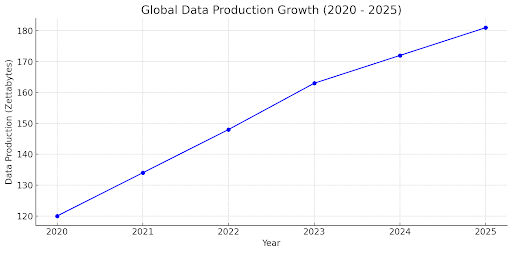
Intuition vs Data Driven Decision Making
We live in a time where data is produced in almost unimaginable amounts. Every year, we now produce over 120 zettabytes of data, and by 2025, this is expected to rise to 181 zettabytes. On any given day, we send 294 billion emails and publish 500 million tweets .
Despite the flood of data:
- Data Overload: The vast amount of data can inform but also overwhelm decision-making processes.
- The Need for Intuition: Intuitive insights, grounded in human experience, remain vital for navigating decisions that data alone can't resolve.
This blog explores the debate between relying solely on data versus the enduring value of intuition. We'll look at how successful companies integrate both to optimise decision-making, ensuring a blend of analytical precision and human insight.
Understanding Data Overload
Data overload occurs when the sheer volume of information available exceeds our capacity to process it effectively. This phenomenon can lead to decision paralysis, where making informed choices becomes increasingly difficult because there's just too much information to handle. This challenge is prevalent in businesses where making timely and accurate decisions is crucial for success.
The Role of Intuition in Decision-Making
Even with advancements in data processing technology, human intuition remains essential in decision-making. Intuition is our ability to understand something instantly, without needing to consciously think it through. It plays a crucial role alongside data, offering insights that numbers alone might not reveal. This becomes especially important in situations where data is missing or things are changing quickly, helping us navigate decisions that lack clear, numerical guidance.
Balancing Data with Intuition
The most successful individuals and companies know that the key to effective decision-making lies in balancing hard data with human intuition. This integrated approach maximises the strengths of both analytical and intuitive aspects of decision-making. Here’s how various industries utilise this balance:
- Healthcare: In healthcare, big data helps manage everything from patient records to treatment plans. However, doctors still rely heavily on their clinical judgement to make final decisions.
- Finance: Financial analysts use vast amounts of market data to predict trends but must also rely on their instincts when unforeseen market changes occur.
- Retail: Retailers analyse customer data to predict purchasing trends. Yet, the final layout of a store or the design of a marketing campaign often relies on intuitive understanding of consumer behaviour.

Statistics That Illuminate the Impact of Data
The most successful individuals and companies know that the key to effective decision-making lies in balancing hard data with human intuition. This integrated approach maximises the strengths of both analytical and intuitive aspects of decision-making. Here’s how various industries utilise this balance:
- Daily Data Interactions: Every day, we engage with a vast array of digital content, contributing to the 2.5 quintillion bytes of data created daily.
- Growth of Data: The exponential growth in data is highlighted by the expected increase from 120 zettabytes in 2020 to 181 zettabytes by 2025.
Challenges of Data Management
Managing this vast amount of data presents significant challenges:
- Security: As data grows, so do the risks associated with data breaches and cyber-attacks.
- Privacy: With more data comes greater responsibility to protect individual privacy, a concern that is increasingly at the forefront of public consciousness.
Examples of Data-Driven Success
- Netflix: Uses algorithms to analyse viewer preferences and suggest personalised content, significantly enhancing user engagement and retention.
- Amazon: Employs data analytics to optimise everything from inventory management to personalised shopping experiences, driving sales and customer satisfaction.
The Future of Data and Decision-Making
Looking ahead, the integration of data analytics and intuitive decision-making is set to deepen. Emerging technologies such as artificial intelligence (AI) and machine learning are enhancing our ability to sift through large datasets, making predictive analytics more accurate and insightful.
Conclusion
The best way for businesses to succeed in the future is by using both data and their own judgement. At Accropolix, we help our clients find the right mix of using facts from data and trusting their instincts. This helps them make good decisions that can lead to success in a world where understanding data is becoming more and more important.



